Engine TAD550GE
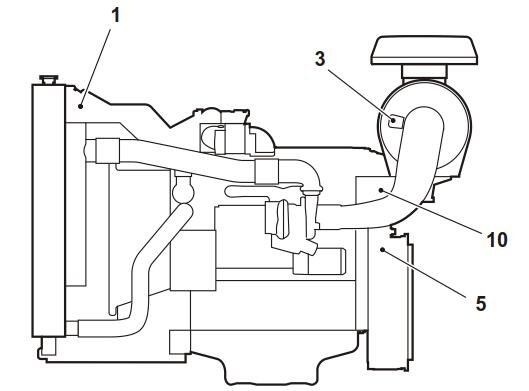
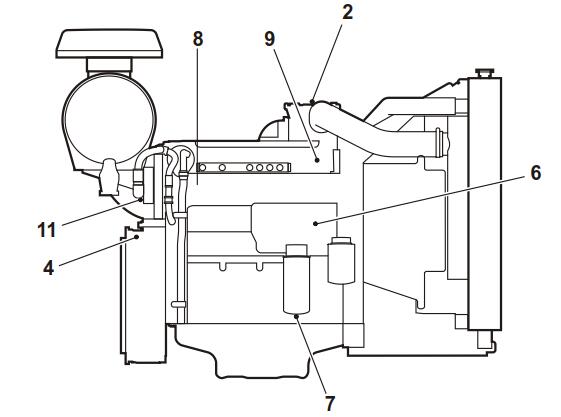
1 Coolant level sensor, in expansion tank
2 Charge air temp and pressure sensor
3 Air filter indicator
4 Crank sensor (RPM)
5 Fuse
6 Oil pressure sensor
7 Water in fuel sensor
8 Fuel pressure sensor, (low press)
9 Fuel pressure sensor, (high press)
10 Coolant temperature sensor
11 Camshaft position sensor
Engine TAD750/751GE
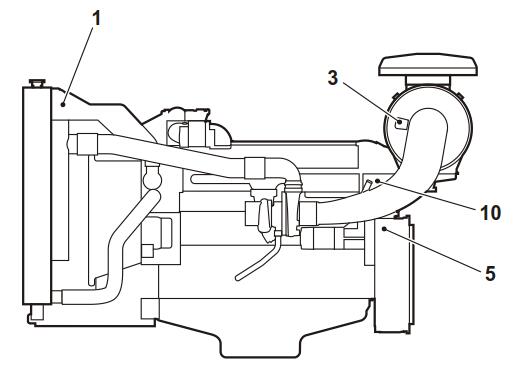
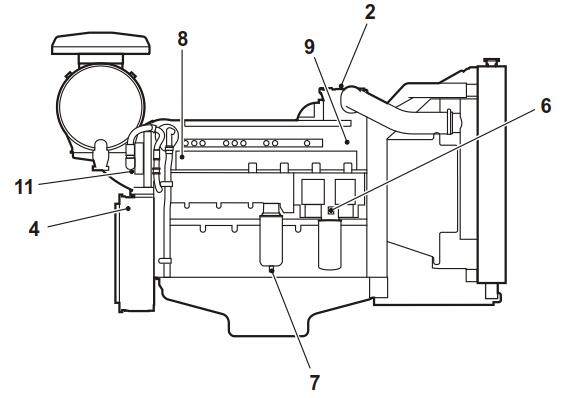
Connection, General
• The installation must be prepared for well and carried out with the greatest care.
• Secure the connecting cable between the engine and instrument panel with clamps. Bear in mind that connector blocks must be mechanically secured so that they are not exposed to any pulling forces.
• The cables must not be run close by hot engine components or close to any other heat source. Ensure that the cables are protected from mechanical wear, sharp edges and water splashes. If necessary, the cables can be run through conduits.
• As far as possible, avoid splices in the system wir-ing. The cables and any splices must be accessible for inspection and service.
NOTICE! Connectors must be assembled “dry”, they must not be filled with petroleum jelly or similar.
NOTICE! The engines are equipped with 2-pole elec-trical systems. This means that the battery negative cable must be connected to the engine block or the flywheel housing.
The battery positive cable may be run via a main switch to terminal 30 on the starter motor.
The battery negative cable must be connected to the engine block or the flywheel housing, close to the starter motor. Refer to the illustration below.
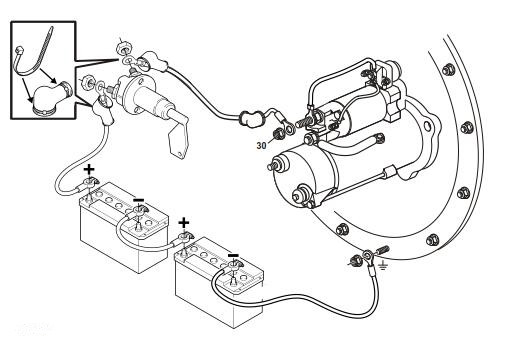
Battery specification
Max. battery 2x220 Ah (series connected), 1150 A CCA EN.
Battery charging
Standard for all engines is that batteries are supplied with power from the alternator
Battery cable cross-sectional area
The total length (L) of the positive and negative cables determines cable cross sectional area (A).
Max L | (m) (ft) | 8 26.2 | 10 32.8 | 13 42.6 |
Min A | (mm2) (in2) | 70 0.11 | 95 0.15 | 120 0.19 |
WARNING!
Due to fire risk, the cable area should never be less than 70 mm2 (0.1 inch2).
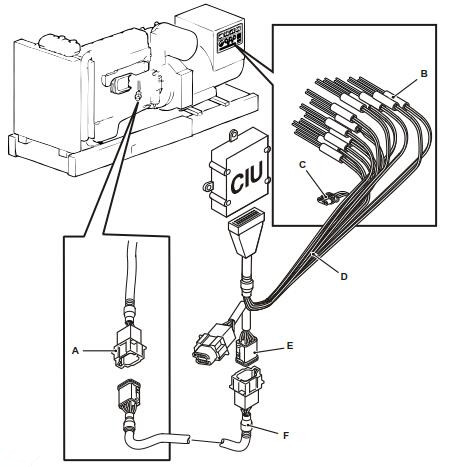
A 8-pin Deutsch connector, from wire harness to engine
B Connectors, analog instruments E 8-pin Deutsch connector
C 3-pin Deutsch connector, Easy Link instrument
D For the connection cable, refer to the Instru-ments page 51 section.
F Extension cables, available in the following lengths: 3, 5, 7, 9, and 11 m
Engine system voltage start current (control unit) is 10 A. Ensure that other components in the installation are dimensioned for this current load.
Start switch
Switch type: closing (NO), spring loaded.
Stop switch
Switch type: closing (NO), spring loaded.
The stop switch is energized during operations via a parameter setting. In this case use a normally closed (NC) switch.
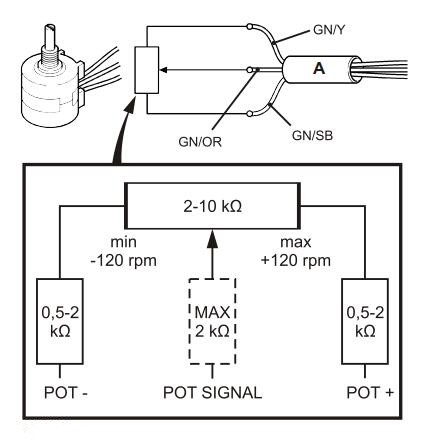
RPM potentiometer
Nominal revolutions minus 120 rpm: 0.3–1.9 V (preset value 1.17 V)
Nominal revolutions plus 120 rpm: 1.9–4.7 V (preset value 4.5 V)
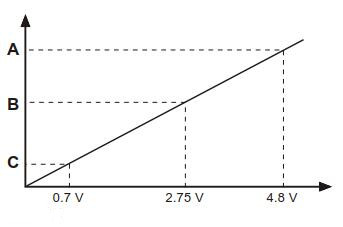
1500/1800 rpm switch
Two-position contact.
This function allows a frequency change from 50 to 60 Hz.
Idle switch
Two-position contact.
Closed contact provides idle rpm.
Droop value switch
Two-position contact.
The switch must be closed to provide rpm droop value.
Primary control switch
Two-position contact.
Contact, pre-heating
Two-position contact.
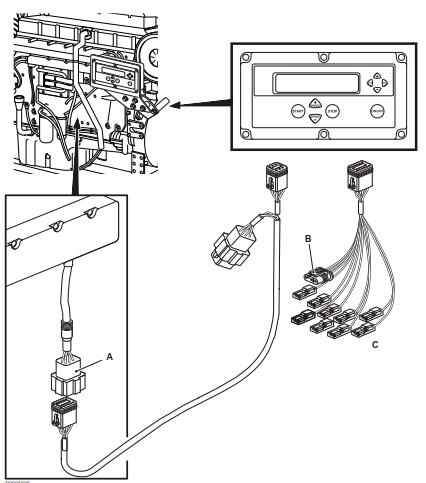
A 8-pin connector from the engine wire harness.
B 3-pin Deutsch connector, Easy Link instrument
C Connectors, analog instruments (options)
The DCU is connected via the 8-pin databus connector block.
Display (optional)
Switch type: closing (NO), spring loaded.
Stop switch (optional)
Switch type: closing (NO), spring loaded.
Warning and control lamps (options)
Running indication:
Max. power 3 W
Voltage 24 V
Easy Link Instrument (option)
Refer to the System Information page 33 for the engine concerned.
For parallel connection of up to 20 extra VDO instru-ments.
The instruments will automatically find their own parameter group from the databus. Maximum Easy Link cable length is 3 m.
The following instruments are available:
• Tachometer/operating hours
• Coolant temperature
• Oil pressure
• Oil temperature
• Battery voltage
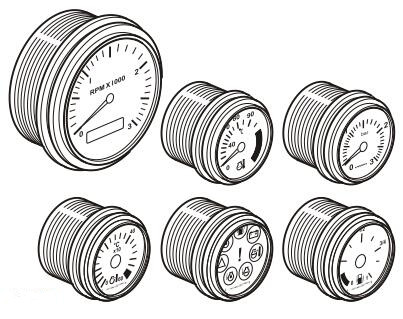
Refer to the System Information page 33 for the engine concerned.
Tachometer
Use Volvo Penta standard tachometer, graduations 0– 2600 rpm.
Setting code 14. Refer to installation instructions.
Oil pressure gauge
Use Volvo Penta oil pressure gauge, graduations 0– 10 bar (0–145 psi).
Oil temperature gauge
Use Volvo Penta oil temperature gauge, graduations 40–150 °C (104–302 °F).
Coolant temperature gauge
Use Volvo Penta oil temperature gauge, graduations 40–150 °C (105–300 °F).
Diagnostics switch
Switch type: closing (NO), spring loaded. For reading fault codes, refer to the Calibration and Settings page 72 chapter.
Contact, pre-heater
Switch type: closing (NO), spring loaded. This contact activates the pre-heating.
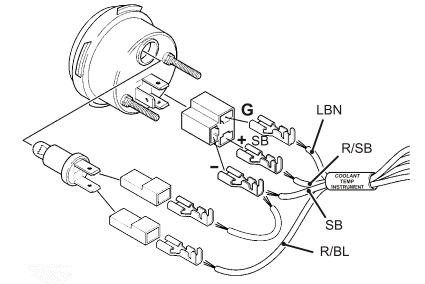
Synchronization/load distribution
The system is adapted for GAC synchronization and load distribution. Use the EAM122 interface module when connecting to this system. When this system is used, voltage levels must be adjusted simultaneously with VODIA, according to the below.
NOTICE! The EAM122 interface module is not sold by Volvo Penta. Contact a GAC (Governors of America Corporation) dealership.
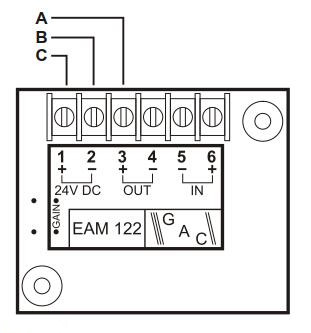
A Rpm control (GN/NO)
B Rpm control (GN/SB)
C Contact to (R/BL 1.5)
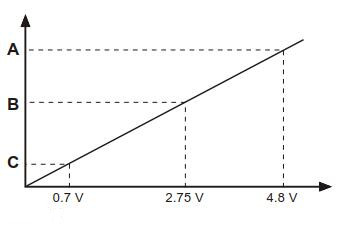
A Nominal revolutions +120 rpm
B Nominal revolutions (1500/1800 rpm)
C Nominal revolutions –120 rpm
The above Volvo Penta engine control system installation is only suitable to Volvo industrial engine for the genset. If you want to know about Volvo power generation, welcome to contact us.
Copyright © Guangxi Dingbo Generator Set Manufacturing Co., Ltd. All Rights Reserved | Sitemap
Update cookies preferences